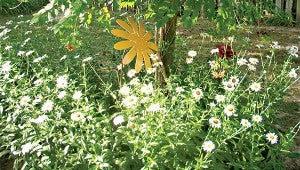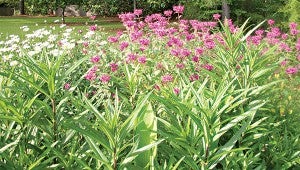Wildlife will enhance a garden
Published 12:00 am Sunday, June 15, 2014
Wildlife Biologist John DeFazio urged attendees at the State Master Gardener Conference last month in Oxford to develop residential gardens that nurture both humans and wildlife. As urban sprawl increases there are fewer undisturbed sections of land for habitat every year. Gardeners can easily create corridors or islands of habitat by planting trees, shrubs and ornamentals that are attractive to wildlife.
“I plant what I like,” Dianne Smith admits.” “And I’m partial to red and yellow blooming plants.” Many of the plants in her yard are not only bright but are favorites for attracting hummingbirds, butterflies and bees.
She has islands filled with plants in both her front and back yard. The front has more direct sun, allowing her to grow sun-loving plants that attract hummingbirds such as lantana, verbena, stokesia, zinnia, penta, petunia, cleome, coral bean and bee balm. Several large hibiscus (which she carried through the winter in her garage along with her Meyer Lemon tree) grow in pots near the fence surrounding the backyard.
A huge native trumpet vine has been trained up a wooden post in the center of the backyard and cascades around all sides of the post hiding a birdhouse that one has to look carefully to see amongst the foliage.

Orange blooms will soon appear on this native trumpet vine to delight the
hummingbirds that frequent the Smith garden.
Turk’s Cap, coral honeysuckle and pineapple sage are other hummer favorites that grow in the partially shaded backyard. Three hummingbird feeders hang in the area as well, and are being drained daily by more hummers this year than normally frequent their feeders according to Smith.
Most of the plants already mentioned attract butterflies as well but Smith has incorporated additional plants and trees into the landscape that are butterfly hosts or nectar sources. Oaks support more caterpillars than any other species according to Kristin Lamberson of Strawberry Plains, another speaker at the Master Gardener Conference.
Tall oaks provide shade to much of the Smith backyard and are under-planted with dogwoods and a red sugar maple she brought back from the Smokey Mountains. Bright white Shasta daisies, passion vines, one of which has a beautiful bright red bloom, Sweet Bay Magnolia, Black Knight purple butterfly bush, Texas Hibiscus, gaura, impatiens, swamp sunflower, wisteria, River Birch, plum, Confederate Rose, phlox, azaleas, sedums and parsley are planted here and there in the Smith garden. All of these are ideal choices for Mississippi butterfly gardens.
“I’m also a deadheader,” Smith commented. Deadheading is an important way to not only keep plants attractive and tidy but to stimulate hormones that direct plants to grow and produce additional blooms. When flowers are allowed to go to seed a plant thinks it has fulfilled its purpose and either quits producing new flowers or dramatically slows down the process. Smith indicated that the chore is never ending but worth the effort in this garden filled with so many blooming plants.
Multiple birdbaths and houses are nestled into many of the Smith garden islands, along the fence and even near the front porch where a family of bluebirds is living, partially hidden by a gaura that is in full bloom.
The Smiths had to cut down a large tree several years ago in their backyard and Smith has found a way to not only conceal but utilize the stump as a way to elevate a birdbath surrounded by an assortment of perennials that provide cover to small birds vary of predatory hawks and other larger birds of prey. Tucked into another flowerbed is a very shallow birdbath that sits on the ground and allows both butterflies and frogs to access water.
Smith’s husband Joe enjoys the flowering plants and helps with much of the planting and maintenance of the yard but he leans more to fruit producing plants and trees.
He has a number of blueberry plants heavy with fruit just beginning to ripen, an apple tree, several plums and wants to plant a fig tree in the near future. He devised a contraption from a handheld fishnet attached to a long pole that allows him to harvest plums from the top of his trees. Of course, fruit is a favorite of many birds and they probably consume as much fruit from these sources as do the Smiths but there is plenty to share.
Wildlife friendly gardens all share the same criteria. They have places with food, water, cover from predators and shelter for wildlife. Smith may be planting things she likes but in the process has developed a lush island of habitat that is home to birds, butterflies, bees and other small creatures as well as a beautiful restful place for humans to get in touch with nature.
Miriam Jabour, a Master Gardener and Master Flower Show judge, has been active in the Openwood Plantation Garden Club for over 35 years. Write to her at 1114 Windy Lake Drive, Vicksburg MS 39183.






